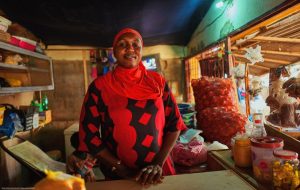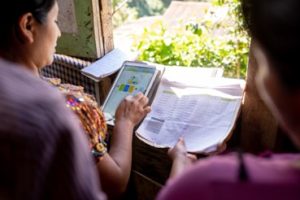How to make sure that "transversal integration of gender" does not remain an empty phrase?
Transversal gender integration in agricultural risk management (ARM) assesses the effect of ARM on diverse gender identities, youth and minority groups that are more vulnerable than most. Agriculture has been pivotal in helping minority groups earn a decent livelihood after being turned away by their communities (as in the case of transgender women finding sanctuary on Colombian coffee farms).[1] Around the world, women farmers contribute over 40% of farm labor[2] with agriculture being one of the most easily accessible employment for women.[3] Youths are also not to be overlooked as they currently make up 1.2 billion of the world’s population which is a resource waiting to be tapped into as the need for agricultural services increases yearly at an astounding rate.[4] The question is, how do we integrate these topics into ARM project design?
Supporting governments in the design of ARM investment projects integrating gender
The Platform for Agricultural Risk Management (PARM) hosted by IFAD provides an in-depth agricultural risk analysis with a value chain lens, following a holistic approach to identify tools for risks mitigation. PARM also supports governments in co-designing investment projects/programmes to implement tools for ARM, integrating gender.
Since 2021, PARM supported the co-design of 4 projects in Africa (Ethiopia, Burkina Faso, Senegal and Niger), ensuring tailored actions and activities were included in different projects components for women, youth and other vulnerable groups, since PARM strongly recognizes the impact of gender-based constraints and restrictions on smallholder farmers’ ability to participate in decision-making processes and to access services for robust ARM).
In 2019, PARM published its study titled “Gender in agricultural risk management” which presents analytical and operational guidelines for integrating gender into ARM processes. The guide draws extensively on existing analytical work and experiences of IFAD, FAO, World Bank and many other development agencies to advance an approach on how to assess agriculture risks and design agricultural risk management tools with a gender lens. This study served as a foundation for the consideration and integration of gender aspects in the various projects already developed by PARM in close collaboration with governments.
The inclusiveness needs for an integrated and multi-level approach
Integrating gender and youth dimensions into a project is not exclusively a matter of developing stand-alone measures, but rather of ensuring that the gender spectrum is meaningfully integrated at all levels. A minimum of 10% of budgets should be set aside to integrate activities that support the inclusion of women, youth and other vulnerable groups. Intentionally setting aside specific parts of governmental budgets for the inclusion of minority gender groups can raise global yields by as much as 4% which reduces worldwide hunger and poverty.[5]

We need to include women, youth, and other marginalized groups in all consultation processes to ensure their meaningful participation and contribution. In particular, identify specific competencies of women and youth in the ARM and value these competencies in the consultations to lead to concrete actions. This requires a gender-balanced composition of participants, and gender-transformative planning and implementation-including facilitation methods that address social norms. Some methods of application are building learning communities, bridging structures, and information dissemination meetings. In 2022, Mezzanine (a South African digital solutions company) worked with Vodafone and the Department of Agriculture to provide subsidies to smallholder farmers, with a focus on women and youth.8 They used methods such as Community and NGO online and in-person discussions to understand community’s needs, which helps them digitalise agriculture better, providing smallholder farmers with agricultural information and teaching programs on financial services on necessary subjects like agricultural risk insurance and markets.[6]
Training activities to build a skills-package for women’s needs
It is equally important to include women, youth and other marginalized groups in all training activities, making the entire process gender transformative-from design to planning and implementation. In particular, assess the skills, learning and management methods of women’s famers organizations, youth organizations, and other marginalized groups in order to tailor a skills-building package to their specific needs in the ARM. This includes targeted communication and recruitment to ensure gender balance among participants, the adaptation of training materials and modalities, ensuring logistics (security, mobility, scheduling, childcare), facilitation language, methodology, and post-exercise services (practical application, learning retention, mentoring, etc.). These transformative approaches incorporate training for the learning community, training for women and youth on investment opportunities, development of training materials, field schools, forums, caravan talks and specific training. It is equally central to train project partners working with populations on the gender approach and particularly on detection, prevention, mitigation and response to the risks of gender-based violence.

The importance of gathering gender-specific data to ensure tailored actions
Furthermore, all other activities, processes, services and products should be designed to take into consideration the specific needs, constraints and potentials of women, youth and other marginalized groups. All partnerships with public and private sector members should also ensure that actions, products and services are formulated to benefit these groups. The practice should encompass communication strategy, ICT innovations/digitization, as well as identification of investment opportunities.[7] To accomplish this, data needs to be disaggregated by sex and age when collating gender-specific data. This begins with a commitment to target women, youth, and other vulnerable groups equally and equitably in interventions. Particularly, disaggregation includes an ongoing analysis of how agricultural risks affect and are managed differently by population subgroups based on their sex, age, and other factors, such as disability. Examples of data gathering include, but are not restricted to – Mapping, Databases, Feasibility Studies and Evaluations.[8]

To ensure that these applications continue, engagement in a continuous process of evaluation, learning and knowledge management around gender issues in consultation with all stakeholders and sharing relevant results are key. The applications should consist of a learning community, database sharing, dissemination meetings, policy briefs and webinars. These steps will ensure that transversal gender integration becomes the norm, instead of the exception.
Author: Desiree Zwanck, Gender Expert, PARM
Listen to the episode 1 of the FARM-D podcast with Ms Désirée Zwanck, interviewed about the topic by Dorcas Mayala Ntumba, PARM Knowledge Management Specialist and FARM-D Senior Manager.
